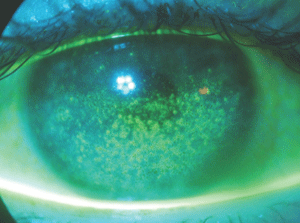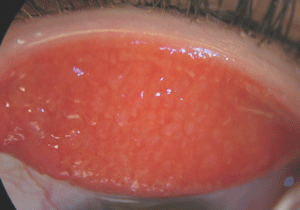Since it first went on the market in 1997, the daily disposable soft contact lens has become an important niche product in the contact lens industry. The innovative molding technology allows the lenses to be manufactured at minimal cost, so they can be worn once and thrown away immediately after wear.
These lenses nearly eliminate the need for cleaning and care solutions. Their secondary benefits include decreased ocular complications due to lack of cleaning or toxic solutions, enhanced overall convenience, and improved comfort because a new lens is being worn each day.
Clinical Benefits

A study found a lower number of patients exhibited corneal staining
after using disposable lenses compared to extended wear. Courtesy: Dr.
Christine Sindt
Numerous studies have investigated the achieved ocular health benefits of daily disposable CLs. One study found an increased rate of microbial keratitis in daily disposable CLs hence indicating that oxygen and CL case contamination are not the only causes for infection.1 Many other studies reported, as theory would predict, that ocular complications were less common with daily disposable CLs than with other lens modalities, making them one of the most trouble-free contact lenses on the market.2-6 As a result, younger patients—in particular, those who may not be as diligent in cleaning their lenses—could benefit from the lower complication rate.
This reported lower complication rate is most likely due to the lenses’ daily replacement frequency, which results in fewer deposits, less solution toxicity/hypersensitivity complications and fewer secondary ocular complications.
Also, the clinician benefits as well; there are fewer subjective patient problems, which results in less unscheduled patient visits. Another study found that a lower number of patients exhibited corneal staining after using daily disposable lenses than after using extended-wear lenses.7 Furthermore, other studies reported that daily disposable CL users are the most compliant with the recommended replacement frequency of their lenses.8 Patients who wore daily-disposables were the most compliant (82%), according to researchers, followed by one-month disposable users (34%) and finally, two-week disposable users (25%).8 The main reason patients were noncompliant? They “forgot which day to replace their lenses,” said 51% of the noncompliant patients. Needless to say, this response does not apply to daily disposable CLs though non-compliant daily disposable users reported that the reused their CLs to “save money.”9
Seasonal Benefits
Daily lenses are particularly beneficial to patients who suffer from redness, itch or tearing caused by chronic or seasonal allergies.10 Out of 128 patients in one study, 67% experienced increased comfort with daily disposable CLs, vs. only 18% of those who wore one-month disposables while experiencing allergy symptoms.
The high replacement frequency of daily disposable CLs alleviates allergy symptoms and improves comfort levels by reducing the buildup of denatured protein and antigens, which could irritate the conjunctiva. Similarly, the accumulation of denatured proteins on the surface of the eye is lowered because this usually occurs with increased CL age.11
Non-Traditional Wear Benefits

Acanthamoeba can occur if patients reuse daily lenses, so be sure to
educate them on the importance of proper compliance. Courtesy: Dr.
Christine Sindt
Daily disposable lenses are also advantageous for part-time wearers—those who want to wear lenses only for certain occasions, such as special events or sporting activities. Not to mention, it’s unlikely that patients who don’t wear CLs on a regular basis will follow proper cleaning regimens while the lenses are in storage. Because the efficacy of the solutions’ disinfection wanes over time and can result in bacterial or fungal growth, the ability to wear a new sterile contact lens and discard it after each use minimizes infections from contact lenses sitting in solutions for a prolonged period of time.
New contact lens wearers can also benefit from daily disposable lenses. New wearers may be unsure how often they would like to wear CLs, and daily lenses can introduce them to contact lenses without having to worry about lens storage.
Daily disposable lenses can also help refractive surgery candidates and post-surgery patients gain perspective on their expected visual results. Lenses can be used to mimic monovision from refractive surgery and allow a patient to determine whether or not he or she can adapt in daily activities to the anisometropia. Post-cataract surgery patients can use daily disposable lenses to minimize their anisometropia until the cataract surgery is performed on the fellow eye.
Or, as an off-label use, daily disposable lenses can also enhance drug delivery to the eye. Daily disposable silicone hydrogel lenses provide more oxygen—and theoretically fewer complications—to post-surgical eyes.
Of course, when daily disposable CLs are used improperly, complications can still occur. One study reported a case of Acanthamoeba keratitis in a patient who wore his daily disposable CLs over multiple uses.12 Remember to tell patients that the benefits of lower infection rates are only seen if the daily disposable lenses are used properly.
Prescribing Trends

Complications can still occur with daily disposable lenses; however,
occurrences of GPC have been minimized. Courtesy: Dr. Christine Sindt
It is clear that soft contact lenses make up the majority of all CL fittings. One study reported that soft lenses comprised 90% of all CL fittings worldwide.13 Silicone hydrogel CLs dominate today’s fits and refits, comprising 29% of all soft lenses prescribed.13
Contact lens patient fits and refits into daily disposables in the United States, however, only comprise about 10% to 13% of the market. This lags behind international trends—roughly 35%, depending upon the region.14
In 2007, it was reported that daily disposable CLs accounted for 43% of all new soft contact lens fits in Japan— but only 5% in the United States.13 At the same time, new daily disposable CL fits were 63% and 57% in Norway and Denmark, respectively.13
The relatively small percentage of daily disposable fits and refits in the U.S. is interesting; other studies found that the majority of practitioners believe patients are most compliant when using daily lenses.14 This poses the question: Why have dailies not seen remarkable success in the U.S. vs. the considerable growth observed in other parts of the world?
Various theories try to explain why daily disposable lenses are not prescribed as much in the U.S. as they are in other parts of the world, such as Japan or the U.K. Considering the current state of our economy, cost remains a major limitation. An annual supply of dailies is generally much more expensive than other CL modalities. The current trend with U.S. practitioners has been to fit more affordable CLs, such as two-week or one-month disposables. Also, in other parts of the world, such as the United Kingdom, there are more part-time CL wearers. This one factor decreases the cost of patients’ CL supplies, yet, it drives the daily disposable CL market.
Silicone hydrogel material is currently unavailable for dailies in the U.S.— another reason for the low fitting rate of this lens.
The most common soft lens complications are giant papillary conjunctivitis and corneal neovascularization. Since giant papillary conjunctivitis can be treated, the shift to silicone hydrogel CLs makes sense from an ocular health perspective. Vistakon will be launching its daily disposable silicone hydrogel CL, AcuVue TruEye, in the U.S. later this year, so it will be interesting to see how the daily disposable CL market may change with its introduction.
Of course, there are concerns with daily disposable silicone hydrogel CLs, including higher costs and the possibility of misuse resulting in complications
And, there will always be patients whose CL prescriptions are unavailable in a daily disposable modality. Lastly, the price of daily lenses is a significant, possibly
prohibitive factor. There will always be patients who find daily
disposable CLs’ price prohibitive vs. that of other modalities. As
such, multipurpose solutions will remain a viable and important
component of CL care.
New Daily Disposable Options
The Role of Multipurpose Solutions
Even if more patients are fit into daily disposable CLs, the need for
multipurpose solutions will not be eliminated. Some patients will opt
for two-week lenses or those with a longer usable life, and these
lenses require a care regimen.
Currently in the U.S., daily disposable CLs are available in spheres, limited torics, presbyopia-correcting designs and colors. The parameters are relatively limited compared to other lens modalities, but these lenses’ parameters are constantly expanding.
In September 2009, for example, CIBA Vision expanded its Focus Dailies Toric lens line to include more axes of astigmatism. Vistakon launched the first daily disposable silicone hydrogel contact lens in 2008 in Europe and in 2009 in Canada. As previously stated, the one-day Acuvue TruEye is scheduled for a U.S. launch in June 2010. This daily disposable revolution should minimize the two most common complications associated with soft contact lens wear: giant papillary conjunctivitis and corneal neovascularization.15 Though complications still occur with daily disposable lenses, GPC has been greatly minimized.16,17 Now, with a Dk/t of 118, corneal neovascularization should also be minimized.
It is possible that the silicone hydrogel one-day disposables might reduce the frequency of certain complications, including microbial keratitis.
Today, the daily disposable CL market is constantly growing due to widening parameters and a greater acceptance of these lenses. It is clear that daily disposable CLs have not eliminated all corneal complications, but it remains one of the healthier and convenient CL modalities currently available.
Dr. Yeung, O.D., F.A.A.O., Dipl., is the Director of the UCLA Arthur Ashe Student Health Optometry Clinic. She is a Diplomate in Cornea, Contact Lenses, and Refractive Techologies through the American Academy of Optometry. Stephanie Makalintal is a third year undergraduate student at the University of California, Los Angeles. She is a pre-optometry student majoring in psychobiology.
1. Dart JK, Radford CF, Minassian D et al. Risk factors for microbial keratitis with contemporary contact lenses: a case control study. Ophthalmology. 2008;115:1647-54.
2. Solomon OD, Freeman MI, Boshnick EL, et al. A 3 year prospective study of the clinical performance of daily disposable contact lenses compared with frequent replacement and conventional daily wear contact lenses. CLAO J. 1996;22(4):250-7.
3. Hamano H, Watanabe K, Hamano T, et al. A study of the complications induced by conventional and disposable contact lenses. CLAO J. 1994;20:103-8.
4. Nason RJ, Boshnick EL, Cannon WM, et al. Multisite comparison of contact lens modalities. Daily disposable wear vs. conventional wear in successful contact lens wearers. AJO. 1994;65;774-80.
5. Jones L, Jones D, Langley C. et al. Subjective responses of 100 consecutive patients to daily disposables. Optician. 1996;211(5536):28-32.
6. Inaba M. 1-day Acuvue vs Focus Dailies. A comparison of comfort, user preference, and incidence of corneal complications. CLAO J 2000;26;141-5.
7. Nichols JJ, Mitchell GL, Zadnik K. Daily disposable vs. disposable extended wear: a contact lens clinical trial. Optom Vis Sci. 2000 Dec;77(12):637-47.
8. Dumbleton K, Woods C, Jones L, et al. Patient and practitioner compliance with silicone hydrogel and daily disposable lens replacement in the United States. Eye & Contact Lens. 2009;35(4):164-71.
9. Dumbleton K, Richter D, Woods C, et al. Compliance with contact lens replacement in Canada and the United States. Optom and vis sci. 2010;87(2):131-9.
10. Hayes VY, Schnider CM, Veys I. An evaluation of 1-day disposable contact lens wear in a population of allergy sufferers. Contact Lens Anterior Eye. 2003; 26(2):85-93.
11. Hart DE. Deposits and coatings hydrogel lens/tear film interactions. In: Bennet E, Weissman BA, editors. Clinical Contact Lens Practice. Philadelphia: Lippincott-Raven; 1996; p 3-5,19-20.
12. Niyadurupola N, Illingworth CD. Acanthamoeba keratitis associated with misue of daily disposable contact lenses. CLAO.2006;269-71.
13. Morgan PB, Woods CA, Knajian R, et al. International contact lens prescribing in 2007. Contact Lens Spect. January 2008.
14. Nichols JJ. Contact Lenses 2008. Contact Lens Spectrum. January 2009.
15. Forister JF, Forister EF, Yeung KK, et al. Prevalence of contact lens-related complications: UCLA contact lens study. Eye & Contact Lens. 2009;35(4):174-80.
16. Choi DM, Godstein MH, Salierno A, et al. Fungal keratitis in a daily disposable soft contact lens wearer. CLAO J. 2001;27(2):111-2.
17. Suchecki JK, Ehlers WH, Donshick PC. A comparison of contact lens complications in various daily wear modalities. CLAO J. 2000;26(4):204-13.


